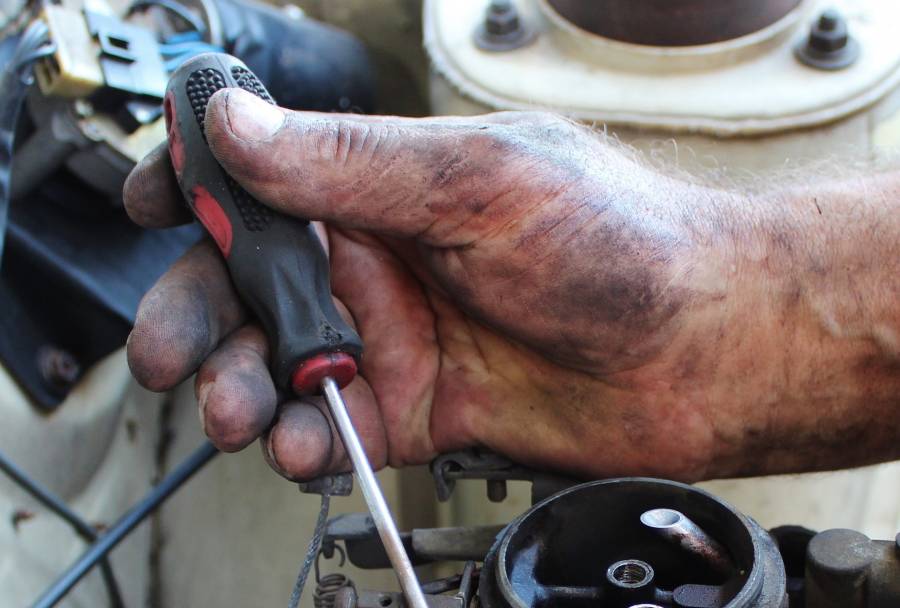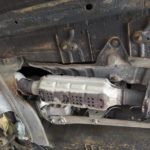Quick Navigation
The engine cooling fans play a vital role in your car. It draws air via the radiator when the vehicle moves at low speeds or idling.
Air may be forced through the radiator at sufficient speeds at high cubic feet per minute. The fan is not needed then.

Today, there are three types of engine cooling fans: flex, clutch, and electric fan. Each has its benefits and limitations.
Understanding this can help you make a more informed decision.
In this guide, we shall be discussing clutch fans and flex fans. Which should you choose between the two?
Keep reading.
Flex Fans
Flex fans are perhaps the most common option for a modern vehicle. These fans use stainless steel frames and blades, either plastic or steel riveted in their frame.
Among the factors that set them apart is their design. Their blades flatten at the present RPM.
It reduces power-robbing drag on the engine, ensuring a smooth operation.
Drag determines how well the fan performs. It’s defined as the power required to turn the fan.
More drag means a significant reduction of possible horsepower. By default, less horsepower leads to a reduction in fuel economy.
Flex fans pull in more air through the radiator than the clutch fans.
This feature is more helpful when the engine runs at high compression ratios, making cooling harder.
It means the engine can cool much faster and better than when any other fan is used.
These fans offer more support in idle or slow-speed applications. However, they pull more horsepower at high RPMs than other fans.
Also, flex fans tend to make more noise when the engine is at low RPM. But this does not affect their operation anyway.
Clutch Fan
Simply put, a clutch fan is a fan that is controlled by a clutch.
Fan clutch works through temperature-controlled coupling found between the water pump shaft and the fan.
It is designed to allow it to operate at low speeds and disconnect at high speeds.
The whole engine runs efficiently and removes heavy load, which causes a burden.
Like any other fan type, a fan clutch is vital for your cooling system. Because of this, you should expect to face a lot of issues.
The cooling fan and the radiator often stand out in automated cooling systems. It leaves the fan’s clutch to be overlooked, yet it requires proper management.
How A Fan Clutch Works
A clutch fan is mainly used to control the fan when it turns on or off. It brings all the airflow as needed.
When the engine faces a drug, the fan slows it down considerably. The main reason for using the clutch is to treat the air drag.
Most clutches come from silicone-based oil to allow fuel generation. The internal reservoir holds the fuel when the fan lets go of the engine.
The fan opens the internal valve, allowing the liquid in when the fan is engaged.
Significant friction happens between the drive plate and the end of the housing, making the fan spin.
The engine offers faster fluid retention if the motor oil has a smooth transmission.
The fan automatically disengages when the valve is closed. Due to its automatic operation, there is no manual insertion of the clutch into the fan.
Different operating mechanisms exist for these fans, although they follow a similar system. They include:
- These are fan clutches that react to the temperature of the water as it rushes over the radiator. The radiator’s heating hits the air above, heating a small bi-metallic coil on the fan clutch. The internal valve releases a heavy silicon fluid that locks the fan blades and pulley.
- Torque-limiting fan clutch. Also, a non-thermal fan clutch, this type reacts to engine speed. The centrifugal valve opens with a high flow of the silicon liquid, locking the fan blades to the pulley. A full engagement is initiated at low RPM, disengaging slowly as the engine speeds.
- Electronic fan clutch. This type does not depend entirely on temperature or speed, although all other features are similar to the two above. The fan clutch carries several sensors that direct when to engage the fan.
Flex Fan Vs. Clutch Fan – Which One Is The Best?
Both flex fans and clutch fans are helpful in a unique way. Flex fans are mostly applicable as a radiator fan clutch used in motor engine suspension.
They form part of the suspension used in running the engine.
On the other hand, clutch fans are specially utilized with the assistance of a clutch, i.e., the valve technique.
Comparison
There are several similarities and differences between the two. For one, they both use mechanical operating mechanisms.
| Flex Fans | Fan Clutch |
| They are made from stainless steel parts. They have blades made from plastic and riveted to the frame. | The fans are generally essential. They function with the assistance of a valve and a clutch technique that allows for easy attachment. |
| The blades flattered out depending on the engine’s RPM. | They feature thermal operation, which is the most crucial part of the clutch. |
| Drag is required to power through the fan. This drag energy is automatically synchronized and does not require too much attention. | They have springs used to drive off the power with the pressure from radiator-generated heat. The spring opens entirely at a specific temperature, forming a way to the chamber. Air from outside comes in through the chamber to cool the engine. |
| There is not much choice when it comes to variation in flex fans. You can only have one type, which may be a limit for some users. | Non-thermal fans are entirely dependent on RPM. The thermal ones don’t need assistance as the centrifugal force pushes the valves against each other, creating a connection.
Thermal fans come in variations too. Standard duty offers about 50-60% of the water pump, which is restored. The heavy-duty fan clutches work at about 60-70%, while super-duty thermal fans promise 70-80% of the water pump when connected. |
Which One To Choose
Clutch fans are generally faster. The chamber opens when the engine overheats, allowing the fan to work faster and cool it down.
Flex fans don’t have this system. It makes them much slower compared to clutch fans.
However, clutch fans may face overheating, which often damages the clutch.
Pick the Clutch fan for stock or slightly improved engines, best overcooling, and applications that go over 6,000 rpm. Flex fans operate at 100% speed of the water pump.
Flex fans are seen as an improvement of the clutch fans as they are lighter and have flattening plates at higher speeds.
Choose Flex fans for slightly modified engines, excellent cooling with reduced drag and high rpm, applications over 8,000 rpm, and lighter design.
Generally, a flex fan is more convenient. However, clutch fans still offer incredible performance.
What then? Go for a cooling system that fits the needs of your engine.
As you can see, both options have their pros and cons. Consider the features we have shared above to make the best decision.
Conclusion
Clutch fans and flex fans are collectively called mechanical or belt-driven fans. They are an excellent choice for stock or slightly altered engines for street vehicles.
However, they cause parasitic horsepower loss as the engine spins them some power.
Another type of fan offers a better alternative – an electric fan. The electrical system of your vehicle power these fans.
They will draw more electrical power, but their efficiency is unmatched.

With comprehensive experience in writing exceptional quality articles and blogs about cars and related stuff, Daniel is one of the finest bloggers and a hardcore car lover we have. He is an ASE certified technician with an across-the-board experience of 10 years in the industry. He could not help tinkering with anything he got his hands on from a young age, which led to his remarkable career in the automotive repair industry.
When he is not under any hood, you can find him on the water or in the woods to pursue his passion for hunting and fishing. He has been writing for multiple sectors and is a regular contributor to several publications.
He currently owns a Nissan 300ZX TT and a Pearl Yellow but plans to upgrade it to 550 HP. His favorites include the Koenigsegg CCX and Lamborghini Diablo 6.0 VT, but for him, the Ferrari 360 Spider is one of the sexiest cars that exists to date.
Being an avid world traveler, he has spent most of his time analyzing the automotive markets, latest technology, and local favorites to enhance his knowledge base. He is currently living in North Caroline, where it’s all about food and coffee and, of course, cars.







